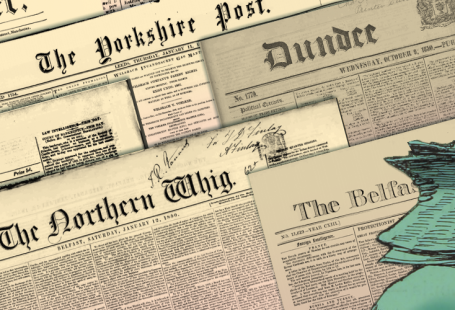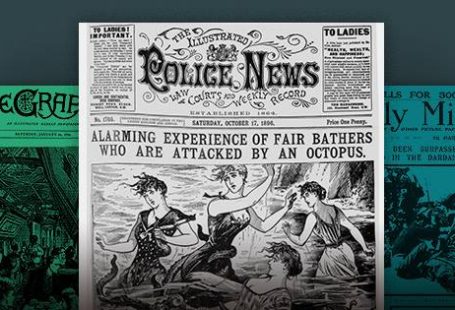This week at The Archive we are celebrating another milestone, as we have now reached over 47 million pages in our collection, with the addition of 194,166 brand new pages over the last week alone. Meanwhile, joining us this week are five brand new newspapers, which comprise of two Irish titles (including a special ‘entertainment journal’), a local Somerset newspaper, a title dedicated to the factory industry in Yorkshire, and an ‘agricultural, commercial and family gazette.’
We have also updated 72 of our existing titles, with updates to our newspapers from the four corners of the United Kingdom and Ireland. Read on to find out more about all of our new and updated titles of the week, as well as to discover more about an early twentieth century controversy: should married women be working in factories or not?
Register now and explore the Archive
We start in Ireland for our tour of this week’s new titles, with County Wicklow newspaper the Bray and South Dublin Herald. First published on 21 October 1876 in the coastal town of Bray, which during the nineteenth century had become a popular resort town, the Bray and South Dublin Herald was a thorough and informative local paper, which appeared every Saturday at a cost of just one penny.

Covering four pages, the Bray title looked at local, national and international news, for example covering the latest from the townships of Bray and Dalkey, as well as including a column from a ‘London Correspondent’ and ‘Miscellaneous Intelligence’ from home and abroad. Meanwhile, the Bray and South Dublin Herald looked at subjects as diverse as ‘The Habits, Thoughts, Wants and Aspirations of Working Men’ and ‘The Present High Price of Meat.’ The newspaper also contained special interest columns like ‘Gardening Operations for the Week,’ and ‘Jottings for the Curious.’
Our second Irish title of the week hails from Dublin, and is ‘entertainment journal’ the Irish Emerald. Initially titled Young Ireland, this newspaper appeared every Saturday at the cost of one penny, and described itself as ‘An Irish Magazine of Entertainment and Instruction.’ Indeed, the Irish Emerald was known as a ‘story paper,’ featuring as it did a range of different stories aimed at both children and adults alike.

As Young Ireland, the newspaper covered two columns, and contained such stories as ‘George Valentine’s Folly or Renounced in Vain’ by Mrs M.A. Fleming and the ominously titled ‘The Mystic Three; Showing What Happened to Three Boys Who Believed All They Read.’ The instructive value of the newspaper was to be found in its ‘Lessons in Gaelic’ column, which was ‘specially written for Young Ireland by one of the founders of the society for the preservation of the Irish language and of the Gaelic union.’ In this column, a poem or piece of prose would be included in Gaelic, with its English translation.
By 1891 the publication had changed its name to the Irish Emerald, and was known for publishing ‘racy Irish tales and sketches,’ although racy then does not quite have the same meaning as it does today! The Irish Emerald expanded to comprise 28 pages, covering three columns, and continued to feature stories like ‘Dead Man’s Chest’ by Harry Hale, and the intriguingly titled ‘The Vulture and The Priest, or, Fettered by a Secret.’

The title continued to devote space to the Gaelic language, with a column called ‘Our Gaelic Readings,’ as well as giving space over to a ‘Boys and Girls Page,’ which featured yet more stories. The Irish Emerald also included a ‘Hearth and Home Section,’ which provided ‘reliable recipes’ and ‘selected hints’ for household management, and a ‘Students’ Page,’ which was conducted by the All-Ireland Correspondence College at Lower Abbey Street, and contained examination results and correspondence.
In 1912 the Irish Emerald was absorbed by comic illustrated penny journal The Shamrock, which ran until 1919.
It’s across the Irish Sea now and over to Somerset for our next new title of the week, which is the Langport & Somerton Herald. This title was first published in the small Somerset town of Langport on 7 July 1855 at the cost of one penny, and appeared every Saturday. Politically neutral, the Langport & Somerton Herald covered four pages and circulated ‘in Langport and neighbourhood.’
An entertaining and lively local newspaper, the Langport & Somerton Herald contained a round of news from the area, reporting how ‘A new Cricket Club has just been established here’ in its first edition, rounding up the news from the town, as well as from Barrington, Bridgewater and Long Sutton, including notices of births, marriages and deaths. The newspaper also looked further afield, containing national and international news, with ‘Foreign Intelligence’ reported from France, Australia, China, India and Russia, and a column dedicated to ‘The World’s Gossip.’

The Langport & Somerton Herald also covered the latest doings in Parliament, as well as looking at more special interest subjects, such as ‘How to Cook Sausages,’ ‘Hints for Wives,’ and a ‘A Gossip With Housewives,’ which looked at how the newspaper should be a ‘household friend.’ Meanwhile, the newspaper contained an ‘Odds and Ends’ column, which included such sayings as this one:
Men are frequently like tea: the real strength and goodness are not drawn out of them until they have been some time in hot water.
The Langport & Somerton Herald ran until 1937.
We move north now for our next new title of the week to Huddersfield, which was where the Yorkshire Factory Times was first published in 1889. An offshoot of the Cotton Factory Times, which had become increasingly Conservative, the Yorkshire Factory Times was socialist in its politics, and favoured New Unionism. Initially edited by Joseph Burgess (1853-1934), a journalist and Labour politician, from 1894 the newspaper was edited by C. Allen Clarke (1863-1935), an English working class humourist, novelist, social investigator and Independent Labour Party member from Lancashire.

So what sort of articles did the Yorkshire Factory Times contain? Covering eight pages and published every Friday, with the John Milton motto ‘Give me, above all other Liberties, the Liberty to Know, to Utter, and to Argue freely, according to Conscience,’ the newspaper cost one penny and looked at factory trades from across the region. For example, it featured columns like ‘Woolsorting Notes,’ ‘Notes on the Dyeing Trade’ and ‘Notes on the Iron Trade,’ as well as articles covering the latest from the ‘Oldham Master Spinners’ Association,’ and a section devoted to ‘Echoes from Yorkshire Mills and Workshops.’
The Yorkshire Factory Times looked further afield, meanwhile, looking at items of industrial interest from abroad, for example covering ‘Workers’ Grievances in Russia’ and a ‘Serious Mining Dispute in Germany.’ The condition of the poor was also widely addressed, the newspaper containing, for example, a look at the ‘Feeding of Poor Children at Bradford,’ as well as covering the general local news from Bradford, Huddersfield, Dewsbury, Batley, the Spen Valley, Wakefield, and Halifax.
The newspaper was also renowned for the fiction it contained, featuring as it did serialized fiction by editor C. Allen Clarke, which brought stories to the working classes who otherwise might not have been able to afford them. For example, the Yorkshire Factory Times published a ‘Powerful Serial of Love and Mystery’ by William Le Queux, which was entitled ‘Whoso Findeth a Wife,’ and a C. Allen Clarke serial called ‘Lancashire Lads and Lasses.’

In 1910 the publication changed its name to the Yorkshire Factory Times and Workers’ Weekly Record, becoming from May 1918 the ‘organ of the textile union’ under the charge of Labour politician Ben Turner (1863-1942), a trade unionist and MP for Batley and Morley from 1922 to 1924, and again from 1929 to 1931. In 1919 Turner renamed his publication to the Labour Pioneer, but in 1922 the title was changed back to the Yorkshire Factory Times and Workers’ Weekly Record, before finally ceasing publication in April 1926.
And now we would like to introduce our final new title of the week, which is Magnet (London). This specialist agricultural newspaper was first published on 13 March 1837, when it described itself as ‘The Largest of the Largest’ and ‘The Cheapest of The Cheapest,’ costing as it did four pence and filling eight pages. Conservative in its politics, by the 1880s Magnet (London) was described as:
One of the largest papers in the kingdom, entirely devoted to the interests of the agricultural community. The reports of the London and provincial corn and cattle markets are given at length in its pages.
The London published newspaper had a usual circulation of 10,000 and appeared every Monday, possessing a ‘large and influential circulation amongst the farmers, millers, and landed gentry of England, Scotland and Wales.’ So what did this ‘Agricultural, Commercial and Family Gazette’ contain? Well, there was its promised agricultural offerings, with columns like ‘The Practical Farmer’ and others devoted to the ‘Foreign Grain Markets,’ a ‘Review of the British Corn Trade’ and ‘Smithfield Market.’

But Magnet (London) also looked beyond agricultural matters to focus on ‘Foreign and Country News,’ containing the latest from parliament, notes on literature, sporting events and varieties, as well as featuring news from the police and the Central Criminal Court. A thorough newspaper, Magnet (London) provides a window on the agricultural history of Britain in the nineteenth century.
With 72 titles updated this week from across England, Wales, Scotland, Ireland and Northern Ireland, we’ve picked out a few highlights for you, although, as ever, you can find a full list of all our updates at the end of this blog. Our picks this week included the 5,000 pages we have added to the Dublin Weekly News, the Newcastle Daily Chronicle and the Deal, Walmer & Sandwich Mercury, as well as the 4,000 pages we have added to the South Yorkshire Times and Mexborough & Swinton Times, and finally the 2,000 pages we have added to the Islington Gazette.
Married Women in Factories – An Early Twentieth Century Controversy
In the early twentieth century, there was much controversy over the issue of married women working in Britain’s factories. Some commentators believed that a woman’s place was in the home, and her working put her family at moral risk. Our new title, the Yorkshire Factory Times, displays both sides of the argument, all the while highlighting how for many married women at the time, they had no choice but to work in the factories.
In October 1915, as more women entered factory work to help with the war effort, one Yorkshire Factory Times commentator pronounced:
The abnormal times through which we are now passing makes it impossible for one to express that thorough disgust one feels with all sections of married women’s work except the most useful and valuable one of the care of the home.

Indeed, another commentator for the same newspaper a year before, in April 1914, denounced married women working in factories as ‘a terrible sore,’ another pronouncing how, ‘candidly,’ they were ‘greatly opposed to the employment of women in mills,’ this time writing in November 1913.
But why was there such opposition to married women working in factories? This 1909 article entitled ‘Married Women in West Riding Factories’ illuminates such detractors’ opinions, writing how such women’s:
…lives often appear to be little better than those of slaves, and many at forty-five are broken-down women, prematurely aged…The moral affect upon the men is very disastrous, it encourages them in selfishness and idleness, and many of them become exceedingly lazy.
So the argument against married women working in factories revolved around the harshness of the work, with her work at the factory and at home to be taken into account, and a moral one, that her husband might become lazy married to a wife who worked.
But for many families across Britain, married women did not have a choice, the 1913 detractor writing how:
…I realise that the existence of some families is altogether impossible without [married women working], and that is where the true evil lies. While men with families are paid 18s to 24s per week their wives will be compelled to work.

Whilst another from 1914 writes how married women are ‘driven’ to factory work ‘as a result of a rotten economic system,’ and ‘Nemo’ in 1915 describes how:
…90 or 95 per cent of married women work in factories and workshops only do so because of economic necessity, because the wages paid to men folks are so low that in order to keep body and soul together and a roof over their heads they are driven out into the world to take their places in the scramble for their existence.
So what was the reality of a typical married working woman’s day in the early twentieth century? The Yorkshire Factory Times in 1909 describes how:
In a number of cases, which come under our notice, the wives work all day in the mill, and on their return tidy the home, baking and washing for their family. Many do not retire until midnight, rising early in order to make some preparation for a midday meal, before going to work. In the dinner hour they quickly return, prepare the meal, swerve the husband and children, swallow their own food far too hurriedly, and again hasten back to their duties.

But the married working women were proud of their labours, one such woman picking up her pen in 1906, to outline her own opinion as a ‘four-loom weaver:’
As a Lancashire woman and a four-loom weaver it has often struck me that the position of the real wage-earner in the cotton trade has never been fairly dealt with. The medical gentlemen who deal in birth and death statistics use very strong language regarding the employment of women in factories, but it seems to me they have hold of the wrong end of the stick. It is the Lancashire woman who is the backbone of the Lancashire cotton industry. Woman against man she earns more money at her looms and is much the better weaver. Further, her earnings to a very large extent go to make the home comfortable and enable the children to be brought up in a respectable manner.
It is her opinion that not only do women make better workers, that their earnings go directly to the maintenance of their families:
Now my case is typical of thousands of Lancashire women who are mothers as well. These women, with a devotedness that is marvellous, allow the husband to keep a good share of his earnings to use as he pleases, whilst nearly every penny they make goes to pay the butcher, the baker, and the candlestick-maker.
She goes on to lambast those who state that a mother’s place should be in the home, writing how, in an illuminating swipe at early twentieth century gender politics:
Your medical doctors and charitable philanthropists say, ‘This must not be, the mother’s place is at home and she ought to stay there.’ Yes, my amiable friends, but who will suffer? Not the man. Do you think he will give up his evenings at the club? Not likely! It is the woman and children who will have to go without all the little comforts that the woman’s wage now makes possible.

Married women had little choice but to work; in many cases there would not have been such a luxury of choice. Meanwhile, our four loom weaver left her audience with this challenge, and a simple solution to the perceived issue of married women having to work in factories across Britain:
If anyone is desirous of bringing about a revolution in Lancashire let him persuade the House of Commons to pass a law forbidding wives to work in the mill! The factory system is part and parcel of our whole life. Municipal and Parliamentary leaders could achieve a vast deal more if they put into operation a few changes as regards tending the babies who are now left in such numbers to do as they please. It would cost little, for instance, to establish a few centres where the little ones could be left while the mothers are in the mill.
New Titles
Title |
Years Added |
| Bray and South Dublin Herald | 1876, 1878-1886, 1888-1889, 1891-1904, 1908-1909 |
| Irish Emerald | 1881-1888, 1890-1912 |
| Langport & Somerton Herald | 1855, 1857-1896, 1898-1937 |
| Magnet (London) | 1837-1888 |
| Yorkshire Factory Times | 1905-1910, 1912-1926 |
Updated Titles
This week we have updated 72 of our existing titles.
You can learn more about each of the titles we add to every week by clicking on their names. On each paper’s title page, you can read a FREE sample issue, learn more about our current holdings, and our plans for digitisation.
You can keep up to date with all the latest additions by visiting the recently added page. You can even look ahead to see what we’re going to add tomorrow.






